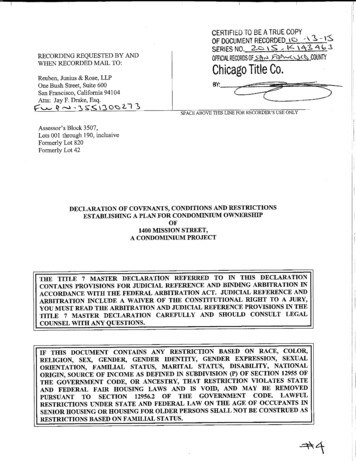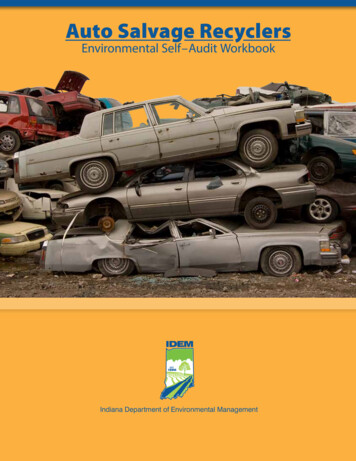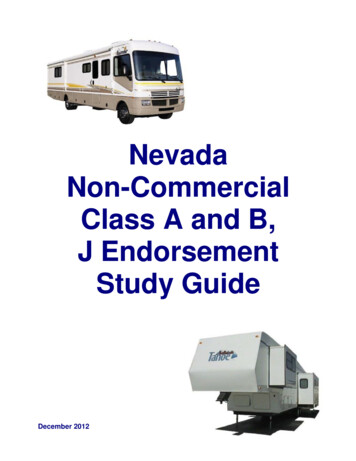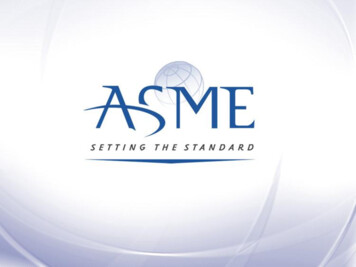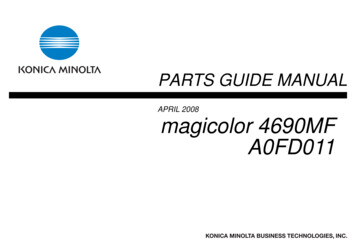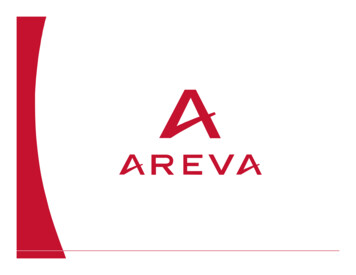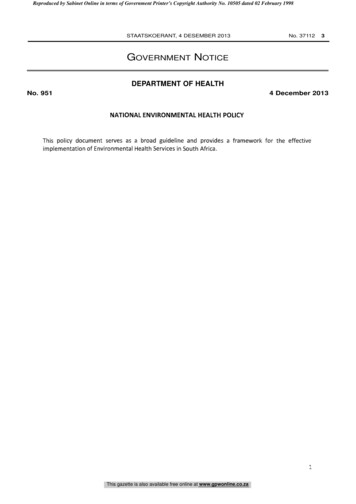
Transcription
BPEC Level 2 Diploma in Plumbing FoundationSection 3 – D/602/2486Understand how to apply environmentalprotection measures within BSEThe content of this document is BPEC Ltd 2020 and may not be copied, reproduced or distributed without prior written consentAuthor: BPEC Ltd. Editor: BPEC Ltd. Design: BPEC Ltd1
BPEC Level 2 Diploma in Plumbing Foundation2D/602/2486 - Understand how to apply environmental protection measureswithin BSEThis knowledge unit provides learning in a range of basic measures associated with protection of theenvironment. Areas covered include the effective use of material resources, minimising wastage. Thelegislation surrounding the effective use of energy and water resources including an introduction to the useof emerging environmental technologies is also covered in the unit. Upon completion of the unit the learnerwill:LO1.Know the energy conservation legislation that applies to the building services industryLO2.Know the applications of energy sources used in the building services industryLO3.Know the importance of energy conservation when commissioning building services systemsLO4.Know the methods of reducing waste and conserving energy while working in the buildingservices industryLO5.Know how to safely dispose of materials used in the building services industryLO6.Know the methods of conserving and reducing wastage of water within the building servicesindustryThe content of this document is BPEC Ltd 2020 and may not be copied, reproduced or distributed without prior written consentAuthor: BPEC Ltd. Editor: BPEC Ltd. Design: BPEC Ltd
BPEC Level 2 Diploma in Plumbing Foundation3Learning Outcome 1Know the energy conservation legislationthat applies to the building servicesindustryThe content of this document is BPEC Ltd 2020 and may not be copied, reproduced or distributed without prior written consentAuthor: BPEC Ltd. Editor: BPEC Ltd. Design: BPEC Ltd
BPEC Level 2 Diploma in Plumbing Foundation4There are two Assessment Criteria in Learning Outcome 1:AC1.1.State the aims of energy conservation legislationAC1.2.Identify the responsibilities of members of the construction team under energyconservation legislationAC1.1 State the aims of energy conservation legislationGeneral LegislationThe Climate Change Act 2008Adopted in November 2008, the Climate Change Act 2008 set targets to reduce carbon emissions to 80%below 1990 levels by 2050. A provisional reduction was set of 34% of 1990 levels by 2020 with a possible cutof 42% (by international agreement). It also established the idea of carbon budgets.The Committee on Climate Change is an advisory committee to the UK Government, which sets targets andthe measures to achieve them.COM 2002/91/EC: EU Directive on the Energy Performance of Buildings and Directive2010/31/EU Directive on the Energy Performance of Buildings recastAcross Europe, 40% of all energy generated is consumed by buildings. This accounts for 36% of all CO2emissions. The Directive on Energy Performance of Buildings (2002/91/EC) was initiated by the EU toachieve energy performance in buildings. There were four main objectives:1) Establishment of a calculation methodology: Member States must implement a methodology forthe calculation of the energy performance of buildings, taking account of all factors that influenceenergy use;2) Minimum energy performance requirements: there must be regulations that set minimum energyperformance requirements for new buildings and for large existing buildings when they arerefurbished;3) Energy performance certificate: there must be an energy performance certificate made availablewhenever buildings are constructed, sold or rented out;4) Inspections of boilers and air-conditioning: there must be regulations to require inspections ofboilers and heating systems (or an alternative system of providing advice as discussed below), andinspection of air conditioning systems.In 2010, was updated to the Energy Performance of Buildings and Directive (EPBD recast). This strengthenedthe objectives laid down in 2002:The content of this document is BPEC Ltd 2020 and may not be copied, reproduced or distributed without prior written consentAuthor: BPEC Ltd. Editor: BPEC Ltd. Design: BPEC Ltd
5BPEC Level 2 Diploma in Plumbing Foundation1) When buildings are advertised for sale or rent, energy performance certificates are to be included.2) Larger public buildings must display a Display Energy Certificate (DEC).3) Inspection schemes must be established for heating and air conditioning systems or measures put inplace with equivalent effect.4) All new buildings must be nearly zero energy buildings by 31 December 2020 (public buildings by 31December 2018).5) EU countries must set minimum energy performance requirements for new buildings, buildings thatare refurbished and renovated, and for retrofitted building elements, such as roofs, walls, heating andair conditioning.6) EU countries must draw up lists of national financial measures to improve the energy efficiency ofbuildings.Energy Performance of Buildings (England and Wales) (Amendment) (No.2)Regulations 2016The original 2007 Regulations werefirst updated in 2012 and again in2016. These Regulations put intopractice articles 7, 8 and 9 of the EUEnergy Performance of BuildingsDirective that dictates that clients andlandlords must produce and displayEnergyPerformanceCertificates(shown left).Under the 2016 amendments, localauthorities must now arrange for theenforcement of obligations under the2012 Regulations, including thoserelating to EPCs, Display Energy Certificates and Air Conditioning energy inspections, in relation to their ownbuildings with the local Weights and Measures authority of another area. In other words, local authoritiescannot certificate their own buildings. Certification must be completed by another authority.Home Energy Conservation Act (HECA) 1995The Home Energy Conservation Act (HECA) places obligations on local authorities to increase energy efficiencyin their housing stock by 30% over a 10 – 15 year timeframe. The Department for the Environment estimatedthat a 30% improvement on UK energy consumption was possible through improved energy efficiency ofhousing stock. The main objectives of the Act are to reduce carbon emissions, thereby helping climate changeand reduce fuel poverty by lowering the cost of fuel bills.The content of this document is BPEC Ltd 2020 and may not be copied, reproduced or distributed without prior written consentAuthor: BPEC Ltd. Editor: BPEC Ltd. Design: BPEC Ltd
BPEC Level 2 Diploma in Plumbing Foundation6Construction Industry Specific Energy Conservation LegislationBuilding Regulations Part L: Conservation of fuel and power (Part J in Scotland andPart F in Northern Ireland)Regulation 26 of the Building Regulations states:‘Where a building is erected, it shall not exceed the target CO2 emission rate for the building .’Schedule 1 of Part L: Conservation of Fuel and Power states that provision for the conservation of fuel andpower must be made by limiting heat gains and losses and by providing building services that are efficient,have effective controls, are properly commissioned and that information is provided so that the building canbe operated efficiently.Part L: Conservation of Fuel and Power deals with the energy efficiency of buildings. This comprehensive setof regulations is divided into 4 separate documents: Approved Document L1A: conservation of fuel and power in new dwellings, 2013 edition with 2016amendments Approved Document L1B: conservation of fuel and power in existing dwellings, 2010 edition(incorporating 2010, 2011, 2013, 2016 and 2018 amendments) Approved Document L2A: conservation of fuel and power in new buildings other than dwellings,2013 edition with 2016 amendments Approved Document L2B: conservation of fuel and power in existing buildings other than dwellings,2010 edition (incorporating 2010, 2011, 2013 and 2016 amendments)The key points of Part L are:1) The designed carbon emission rate (known as the Dwelling Emission Rate or DER) for selfcontained dwellings and individual flats and Building Emission Rate (known as the BER) for buildingsother than dwellings must not exceed the Target Emission Rate (TER) for a theoretical building ofsimilar type, size and shape. DER, BER and TER are expressed in kgCO2/m2 per year.2) Installed building services should achieve a reasonable standard of energy efficiency.3) Solar gains (solar heat through windows and through the fabric of the building) should be limited.4) The performance of the building should be in line with the Dwelling Emission Rate. This includes airpermeability testing and proper commissioning of all building services systems.5) Provision should be made for energy efficient operation by issuing the building owner withinformation, in the form of a log book, enabling them to operate the building in such a way that usesno more fuel and power than is reasonable.6) Limiting heat loss through the fabric of the building by stipulating the U-Values of the various buildingcomponents, such external walls, internal walls, roof, glazing, doors etc.The content of this document is BPEC Ltd 2020 and may not be copied, reproduced or distributed without prior written consentAuthor: BPEC Ltd. Editor: BPEC Ltd. Design: BPEC Ltd
7BPEC Level 2 Diploma in Plumbing FoundationBuilding Regulations Part F: Ventilation (2010 incorporating 2010 and 2013amendments)Part F deals with indoor air quality and, as such, is not an energy efficiency document. However, Part L (seeabove) requires that architects design buildings that are air tight to retain heat and save energy. Ventilationis included in this, as a way of controlling the indoor temperature of a building. An air tight approach tobuildings can lead to sick building syndrome (SBS) especially if the air within the building becomes stale andso it very important that ventilation is applied. The downside to ventilation of buildings is that this leads toheat loss.Part F defines ventilation as the removal of ‘stale’ air from a building, replacing it with ‘fresh’ air from outside.Removing stale air leads to: The removal of airborne odours, pollutants and bacteria The control of humidity Fresh clean air for breathing.Part F also encourages energy efficient controls as an important part of ventilation systems.Building Services Specific Energy Conservation GuidesDomestic Building Services Compliance Guide 2013 (with 2018 amendments)This document supports the current editions of Document L: Conservation of Fuel and Power and providesguidance on complying with the Building Regulations requirements for space heating and hot water systems,mechanical ventilation, comfort cooling, fixed internal and external lighting systems and renewable energysystems. The 2018 amended document came into effect on 6th April 2018.The guide is divided into four fuel-based sections and nine technology-specific sections:Fuel based:Technology-specific: Section 2 Gas-fired space and water heating. Section 6 Community heating. Section 3 Oil-fired space and water heating. Section 7 Underfloor heating. Section 4 Electric heating. Section 8 Mechanical ventilation. Section 5 Solid fuel heating. Section 9 Heat pumps. Section 10 Comfort cooling. Section 11 Solar water heating. Section 12 Lighting. Section 13 Micro-combined heat and power. Section 14 Heating system circulators.The content of this document is BPEC Ltd 2020 and may not be copied, reproduced or distributed without prior written consentAuthor: BPEC Ltd. Editor: BPEC Ltd. Design: BPEC Ltd
8BPEC Level 2 Diploma in Plumbing FoundationStandard Assessment Procedure 2009 (SAP2009) and Reduced Standard AssessmentProcedure (RdSAP) 2012The Standard Assessment Procedure is the method by which dwellings are energy rated. It has been adoptedby the UK Government as part of the national methodology for the calculation of energy performance forbuildings. It is used primarily to demonstrate that a building complies with the requirements of DocumentPart L 1A/B.Central Heating System Specifications (CHeSS)CHeSS gives recommendations for good and best practice for energy efficiency of domestic wet centralheating systems. Customers and clients should consult these specifications to ensure that their heatingsystems meet the current good and best practice.Unlike the Domestic Building Services Compliance Guide, CHeSS is directly aimed at central heating systemsin domestic properties.CHeSS: System description HR7 & 8CHeSS HR7 - Recommended good practice (2008)CHeSS HR8 - Recommended best practice (2008)System descriptionSystem descriptionDomestic Wet Central Heating System with regularDomestic Wet Central Heating System with regularboiler (natural gas, LPG, oil) and separate hotboiler (natural gas, LPG, oil) and separate hotwater store.water store.BoilerBoilerA regular boiler (not a combi) which has a SEDBUKA regular boiler (not a combi) which has a SEDBUKefficiency of at least 86% (bands A and B)efficiency of at least 90% (band A)Boiler (see Notes 5 and 6)Boiler (see Notes 5 and 6)Hot water storeHot water storeEITHEREITHERHot water cylinder, whose heat exchanger andHigh performance hot water cylinder (see Note 8)insulation properties both meet or exceed (seeORnote 7) those of the relevant British Standards.ORThermalHigh-performance thermal (primary) storagesystem (see note 9).(primary)storagesystem,whoseIn suitable buildings, consideration should beinsulation properties meet or exceed thosegiven to fitting a cylinder with an additional heatspecified in Ref [9].exchanger to allow for solar water heating.The content of this document is BPEC Ltd 2020 and may not be copied, reproduced or distributed without prior written consentAuthor: BPEC Ltd. Editor: BPEC Ltd. Design: BPEC Ltd
9BPEC Level 2 Diploma in Plumbing FoundationControls (see Notes 10, 11 and 12)Controls (see Notes 10, 11 and 12) Full programmer Room thermostatadditional timing capability for hot water Cylinder thermostat Cylinder thermostat Boiler interlock (see Note 13) Boiler interlock (see Note 13) TRVs on all radiators, except in rooms with a TRVs on all radiators, except in rooms with aProgrammableroom thermostatroom thermostat Automatic bypass valve(see Note 14)Installation : see Notes 1, 2, 3 and 4roomthermostat,withAutomatic bypass valve(see Note 14)Installation : see Notes 1, 2, 3 and 4CHeSS: System description HC7 & 8CHeSS HC7 - Recommended good practice (2008)CHeSS HC8 - Recommended best practice (2008)Description HC7Description HC8Domestic wet central heating system with combiDomestic Wet Central Heating System withor Combined Primary Storage Unit CPSU boilercombination or Combined Primary Storage Unit(natural gas, LPG, or oil)CPSU boiler (see note 3)BoilerBoilerA combi or CPSU boiler which has a SEDBUKA combi or CPSU boiler which has a SEDBUKefficiency of at least 86% (bands A and B)efficiency of at least 90% (band A)Boiler (see Notes 5 and 6Boiler (see Notes 5 and 6Hot water storeHot water storeNone, unless included within boilerNone, unless included within boilerControls: (see Notes 10, 11 and 12)Control: (see Notes 10, 11 and 12) Time switch Programmable room thermostat Room thermostat Boiler interlock (see Note 13) Boiler interlock (see Note 13) TRVs on all radiators, except in rooms with TRVs on all radiators, except in rooms witha room thermostata room thermostat Automatic bypass valve (see Note 14)Installation : see Notes 1, 2, 3 and 4Automatic bypass valve (see Note 14)More advanced controls, such as weathercompensation, may be considered, but at presentcannot be confirmed as cost effective.Installation : see Notes 1, 2, 3 and 4Notes applicable to CHeSS HR8, HC8, HR7, HC7 (year 2008) (taken from the Energy Saving Trust publication‘Central heating system specifications (CHeSS) Year 2008’)1. Other componentsThe specifications list only the principal components of a heating system affecting energy efficiency. Othercomponents will be required, such as radiators, circulator pumps (see note 4), cisterns (feed and expansiontanks), and motorised valves. All components must be selected and sized correctly.The content of this document is BPEC Ltd 2020 and may not be copied, reproduced or distributed without prior written consentAuthor: BPEC Ltd. Editor: BPEC Ltd. Design: BPEC Ltd
BPEC Level 2 Diploma in Plumbing Foundation102. Design, installation and commissioningHeating systems should be designed to match the heating needs of the buildings in which they are installed.They should be installed in accordance with relevant safety regulations, manufacturers’ instructions, theBenchmark scheme, building regulations, the Domestic Heating Compliance Guide, and British Standards.For oil boilers the OFTEC forms CD/10 and CD/11 (or similar) for installation and commissioning should becompleted. More detailed advice on domestic wet central heating systems is given in the Energy Saving Trustguides, and the CIBSE guide. Commissioning and handover of information on operation and maintenance isa requirement of building regulations and a suitable commissioning certificate should be issued.3. Water treatmentWater treatment is important as it prolongs effective and trouble-free operation. Three types of watertreatment should be considered: Cleaning and flushing of the system before use Corrosion inhibition Softening of the water supply to combi boilers for hot water service in hard water areas.In each case the recommendation of the boiler manufacturer must be followed as damage may be causedby unsuitable treatment. For both new and replacement systems, thorough cleaning is essential. When aboiler is replaced it is essential to drain and flush all old water from the system in case it contains a corrosioninhibitor unsuitable for the new boiler. Advice on the need for treatment and on causes of problems is givenin BS 7593: Code of practice for treatment of water in domestic hot water central heating systems.4. Circulator pumpAdvice on pump dimensioning is available from the BPMA (British Pump Manufacturers’ Association) websiteat www.bpma.org.uk. Pumps installed separately from the boiler (not supplied as part of the boiler unit)which have automatic speed control should not be used in heating systems with TRVs unless the design ofthe pump and system ensures that the minimum flow rate through the boiler (as specified by the boilermanufacturer) is certain to be maintained under all conditions.5. Boiler size and typeThe whole house boiler sizing method for houses and flats gives guidance on boiler size and is available onthe Energy Saving Trust website alculators/boilersizing A regular boiler does not have the capability to provide domestic hot water directly, though it maydo so indirectly via a separate hot water store. A combination (combi) boiler does have the capability to provide domestic hot water directly, andsome models contain an internal hot water store. A combined primary storage unit (CPSU) is a boiler with a burner that heats a thermal store directly.Each of these may be either a condensing or non-condensing boiler, and condensing boilers are always moreefficient. Condensing boilers are fitted with a drain to dispose of the liquid condensate. Building regulationsrequire all new gas and oil boilers to be condensing, whether installed in new or existing housing, unlessThe content of this document is BPEC Ltd 2020 and may not be copied, reproduced or distributed without prior written consentAuthor: BPEC Ltd. Editor: BPEC Ltd. Design: BPEC Ltd
11BPEC Level 2 Diploma in Plumbing Foundationthere are exceptional circumstances that would make the installation impractical or excessively costly. Allboilers in the CHeSS specifications HR7, HC7, HR8 and HC8 are condensing boilers.6. Boiler efficiencySEDBUK (Seasonal Efficiency of Domestic Boilers in the UK) is the preferred measure of the seasonal efficiencyof a boiler installed in typical domestic conditions in the UK, and is used in SAP assessments and the buildingregulations. The SEDBUK efficiency of most current and obsolete boilers can be found on the websitewww.boilers.org.uk. Although SEDBUK is expressed as a percentage, an A to G scale of percentage bands hasalso been defined (see below).7. Hot water cylinder (basic)SEDBUKVented cylinders shall comply with the performanceEfficiency rangeBand90% and aboveA86% – 90%B12897:2006 or be approved by the British Board of82% – 86%CAgrémont (BBA) or other equivalent body. All cylinders must78% – 82%D74% – 78%Eis the capacity in litres. All cylinders shall be labeled with the70% – 74%Fstanding heat loss in kWh/24hours.Below 70%GIndirect cylinders shall also be labeled with the heatrequirements of BS 1566:2002 Type P cylinders. Theperformance of unvented cylinders shall comply with BS ENbe factory insulated such that the standing heat loss will notexceed: 1.6 x (0.2 0.051 V2/3) kWh per 24 hours, where Vexchanger performance in kW as measured by BS 1566:2002 (vented) or BS EN 12897 (unvented). Where cylinder capacity (V) in litres is less than 200, the ratio ofV to heat exchanger performance (in kW) shall not exceed 10; e.g. a 150 litre cylinder shall have a minimumheat exchanger performance of 15kW. Where V is 200 or above the cylinder shall have a minimum heatexchanger performance of 20kW.8. Hot water cylinder (high performance)A high performance cylinder may be either vented or unvented. The manufacturer must confirm that theheat exchanger and insulation properties exceed the requirements of the relevant British Standards. Thestanding heat loss must not exceed: 1.28 x (0.2 0.051 V2/3) kWh per 24 hours, where V is the capacity inlitres. Al cylinders shall be labelled with the standing heat loss in kWh/24hours.High performance cylinders shall comply with the heat exchanger performance and labelling requirementsof basic cylinders, as set out in Note 7.Solar-compatible cylinders contain an additional heat exchanger or other provision for connection to a solarwater heating system. They offer the opportunity to install a solar water heating system at greatly reducedcost and with less disruption in the future. In the case of solar-compatible cylinders the heat exchangerperformance of the upper coil (connected to the boiler) shall relate to the volume of water heated by thatcoil; i.e. the dedicated solar volume shall be subtracted from the total cylinder capacity for the purposes ofheat exchanger assessment.The content of this document is BPEC Ltd 2020 and may not be copied, reproduced or distributed without prior written consentAuthor: BPEC Ltd. Editor: BPEC Ltd. Design: BPEC Ltd
BPEC Level 2 Diploma in Plumbing Foundation129. Thermal store (high performance)A high-performance thermal (primary) storage system must have insulation properties exceeding by at least15% those given in the WMA Performance Specification for Thermal Stores, and comply with thespecification in other respects. Note that the WMA Performance Specification for Thermal Stores is shortlyto be superseded by a revised 2008 specification from the HWA (Hot Water Association).10. Circuits and zonesSystems with regular boilers must have separately controlled circuits to the hot water cylinder andradiators, and both circuits must have pumped circulation. Large properties must be divided into zonesnot exceeding 150m2 floor area, so that the operation of the heating in each zone can be timed andtemperature controlled independently.11. Heating controls A time switch is an electrical switch operated by a clock to control either space heating or hot water,or both together but not independently. A full programmer allows the time settings for space heating and hot water to be fully independent. A room thermostat measures the air temperature within the building and switches the spaceheating on and off. A single target temperature may be set by the user. A programmable room thermostat is a combined time switch and room thermostat that allows theuser to set different periods with different target temperatures for space heating, usually in a weeklycycle. Some models also allow time control of hot water, therefore replacing a full programmer. A cylinder thermostat measures the temperature of the hot water cylinder and switches the waterheating on and off. A thermostatic radiator valve (TRV) has an air temperature sensor which is used to control the heatoutput from the radiator by adjusting water flow.12. Wireless controlsWireless controls are susceptible to radio transmissions and should therefore be designed to a satisfactorylevel of immunity, otherwise they may become unreliable as nearby frequency bands become increasinglyutilised by communication services.Compliance with the essential requirements of the European Radio and Telecommunications TerminalEquipment (RTTE) Directive 1999/5/EC is insufficient, as the directive is designed only to ensure thatwireless products do not cause harmful interference to other transmissions. It does not give any assurancethat the product has a satisfactory level of immunity to interference from other radio transmissions.13. Boiler interlockBoiler interlock is not a physical device but an arrangement of the system controls (room thermostats,programmable room thermostats, cylinder thermostats, programmers and time switches) that ensure thatthe boiler does not fire when there is no demand for heat.The content of this document is BPEC Ltd 2020 and may not be copied, reproduced or distributed without prior written consentAuthor: BPEC Ltd. Editor: BPEC Ltd. Design: BPEC Ltd
BPEC Level 2 Diploma in Plumbing Foundation13In a system with a combi boiler this can be achieved by fitting a room thermostat. In a system with a regularboiler this can be achieved by correct wiring interconnection of the room thermostat, cylinder thermostat,and motorised valve(s). It may also be achieved by more advanced controls, such as a boiler energymanager. TRVs alone are not sufficient for boiler interlock.14. An automatic bypass valveAn automatic bypass valve controls water flow in accordance with the water pressure across it, and is usedto maintain a minimum flow rate through the boiler and to limit circulation pressure when alternative watercircuits are closed.A bypass circuit must be installed if the boiler manufacturer requires one, or specifies that a minimum flowrate has to be maintained while the boiler is firing. The installed bypass circuit must then include anautomatic bypass valve. Care must be taken to set up the automatic bypass valve correctly, in order toachieve the minimum flow rate required (but not more) when alternative water circuits are closed.AC1.2 Identify the responsibilities of members of the constructionteam under energy conservation legislationDesigners, builders and installersThe Building Regulations give clear guidance as to who is responsible for ensuring that the work completedcomplies with all aspects of the Regulations. It states that:‘People who are responsible for building work (for example the agent, the designer, the builder or theinstaller) must ensure that the work complies with the applicable requirements of the BuildingRegulations.’Clients (customers)The Building Regulations state that:‘The building owner may also be responsible for ensuring that the work complies with the BuildingRegulations. If a building does not comply, the building owner may be served with an enforcementnotice.’The content of this document is BPEC Ltd 2020 and may not be copied, reproduced or distributed without prior written consentAuthor: BPEC Ltd. Editor: BPEC Ltd. Design: BPEC Ltd
14BPEC Level 2 Diploma in Plumbing FoundationAdvertThe content of this document is BPEC Ltd 2020 and may not be copied, reproduced or distributed without prior written consentAuthor: BPEC Ltd. Editor: BPEC Ltd. Design: BPEC Ltd
BPEC Level 2 Diploma in Plumbing Foundation15Learning Outcome 2Know the applications of energy sourcesused in the building services industryThe content of this document is BPEC Ltd 2020 and may not be copied, reproduced or distributed without prior written consentAuthor: BPEC Ltd. Editor: BPEC Ltd. Design: BPEC Ltd
BPEC Level 2 Diploma in Plumbing Foundation16There are five Assessment Criteria in this Learning Outcome:AC2.1.Identify the types of energy used in propertiesAC2.2.Identify the basic operating principles of installations containing environmental energy sourcesAC2.3.Identify organisations which give guidance and advice on energy saving and conservationtechniques.AC2.4.Identify how to use energy rating tables and their effect on component selection.AC2.5.State where to find information on alternative energy sourcesOver recent years, there has been and continues to be much debate over the impact of Carbon Dioxide onthe environment. Global warming is a phenomenon that is real and here, but it should be remembered thatCO2 is not a pollutant. Neither is it a contaminant. It cannot contaminate nor pollute. It is a naturally occurringgas that is ever present because life on earth is based around carbon and water. However, it can saturate.Too much CO2, however natural, has a detrimental effect on the climate and its reduction is key to theprevention of continued global warming.AC2.1 Identify the types of energy used in properties, and AC2.2Identify the basic operating principles of installations containingenvironmental energy sourcesEnergy that is used in properties can be divided in to three main categories: High carbon energy sources Low carbon/carbon neutral energy sources Zero carbon energy sources.Within each of these categories are further sub-divisions and each will be considered in turn.High carbon energy sourcesHigh carbon energy sources are so called because they contain high concentrations of carbon. Carbon (C) isthe building block for all life on planet Earth. Every living plant, animal, insect and
BPEC Level 2 Diploma in Plumbing Foundation 2 D/602/2486 - Understand how to apply environmental protection measures within BSE This knowledge unit provides learning in a range of basic measures associated with protection of the environment. Areas covered include the effective use of material resources, minimising wastage. The

